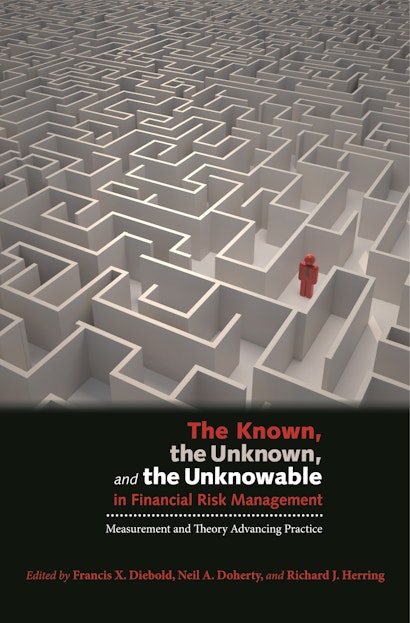A clear understanding of what we know, don’t know, and can’t know should guide any reasonable approach to managing financial risk, yet the most widely used measure in finance today—Value at Risk, or VaR—reduces these risks to a single number, creating a false sense of security among risk managers, executives, and regulators. This book introduces a more realistic and holistic framework called
KuU
—the
K
nown, the
u
nknown, and the
U
nknowable—that enables one to conceptualize the different kinds of financial risks and design effective strategies for managing them. Bringing together contributions by leaders in finance and economics, this book pushes toward robustifying policies, portfolios, contracts, and organizations to a wide variety of
KuU
risks. Along the way, the strengths and limitations of “quantitative” risk management are revealed.
In addition to the editors, the contributors are Ashok Bardhan, Dan Borge, Charles N. Bralver, Riccardo Colacito, Robert H. Edelstein, Robert F. Engle, Charles A. E. Goodhart, Clive W. J. Granger, Paul R. Kleindorfer, Donald L. Kohn, Howard Kunreuther, Andrew Kuritzkes, Robert H. Litzenberger, Benoit B. Mandelbrot, David M. Modest, Alex Muermann, Mark V. Pauly, Til Schuermann, Kenneth E. Scott, Nassim Nicholas Taleb, and Richard J. Zeckhauser.
- Introduces a new risk-management paradigm
- Features contributions by leaders in finance and economics
- Demonstrates how “killer risks” are often more economic than statistical, and crucially linked to incentives
- Shows how to invest and design policies amid financial uncertainty
Awards and Recognition
- Winner of the 2012 Kulp-Wright Book Award, American Risk and Insurance Association
- Finalist for the 2010 Paul A. Samuelson Award, TIAA-CREF
Francis X. Diebold is the Paul F. and E. Warren Shafer Miller Professor of Economics at the University of Pennsylvania and professor of finance and statistics at the university's Wharton School. Neil A. Doherty is the Frederick H. Ecker Professor of Insurance and Risk Management at the Wharton School. Richard J. Herring is the Jacob Safra Professor of International Banking and professor of finance at the Wharton School.
"It is a bold book, tackling both theory and practice and spanning the worlds of (among others) banking, insurance, real estate, and investment. It is also utterly engrossing. . . . Although this book is most obviously addressed to risk managers and regulators, I think it should be read by every intellectually curious person with skin in the financial game. If the investor or trader doesn't come away with at least one or two ideas of practical importance to his financial life, he is a 'sleepreader.'"—Brenda Jubin, Reading the Markets blog
"Peppered with anecdotes and prominent examples, the book never abandons the practical side of its topic. It will be helpful for readers interested in only specific subtopics that each article is a stand-alone piece. I recommend this book to a wide audience: academics and practitioners, of course, but even people who are not directly involved in the financial sector, but are interested in it, will find it definitely worth their time."—Tobias Nigbur, Financial Markets and Portfolio Management
"The financial risk management issues discussed under the KuU framework are highly relevant, and this especially in the light of the subprime credit crisis. Bringing them together in this timely volume will encourage further academic research and remind regulators and practitioners alike first to learn to walk before attempting to run."—Paul Embrechts, RiskLab, ETH Zurich
"This book brings together a series of important and thought-provoking contributions by a group of highly distinguished academics and notable finance practitioners. The organizational principle of the book—the Known, the unknown, and the Unknowable, or KuU—is as relevant and timely as ever. I highly recommend the book to anybody interested in learning about the latest developments and thinking by some of the leading and most influential minds in the area of modern risk management."—Tim Bollerslev, Duke University
"Diebold, Doherty, and Herring have provided tremendous public service in applying their considerable expertise in risk, insurance, and financial institutions to assemble this fascinating collection of papers on risk management—this book should be required reading for anyone with decision-making authority in the finance and insurance industries, and especially among regulators."—Andrew W. Lo, author of Hedge Funds
"This book tackles the complexities of risk management head-on, directly confronting the full range of issues and challenges that permeate the field. It nicely fills a void by offering up thoughtful and disciplined analysis across highly diverse topics. A truly welcome addition to the burgeoning literature on the theory and practice of risk management."—Torben G. Andersen, Northwestern University
"A very informative, interesting book."—Paul Embrechts, coauthor of Quantitative Risk Management
"Each year when I teach my market risk management class, I have one or two senior risk officers from banks give a talk. At the end of the talk I always ask them: 'So what keeps you awake at night?' The answer is virtually always the same: 'Risks that I do not know about.' This book is therefore extremely important in my view. I thoroughly enjoyed reading it."—Peter Christoffersen, McGill University
"I consider this book one of the best compendiums available today on key risk issues facing the global financial system. These are issues whose resolution will determine the nature of the world financial architecture going forward. They will be actively discussed in the months and years ahead, and this volume represents an invaluable resource in this debate."—Ingo Walter, New York University



